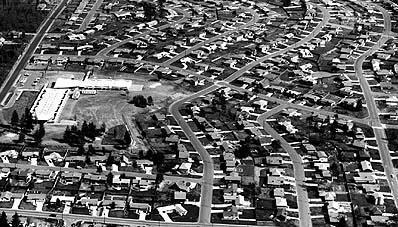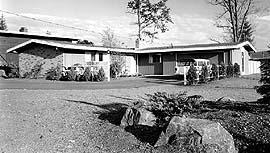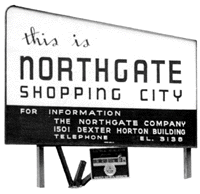By Sharon Boswell
and Lorraine McConaghy
Special to The Times

By 1963, 4,000 ranch and split-level houses sprawled across
1,200 acres of the Lake Hills development.
Photo Credit: Seattle Times.
 Quintessential suburbia: Lake Hills. A station wagon sat in the driveway of this model home,
the "Country Squire," in the Lake Hills development. Builders staged a new show of model
homes each year of construction. Photo Credit: Special Collection, University of Washington Libraries.
Quintessential suburbia: Lake Hills. A station wagon sat in the driveway of this model home,
the "Country Squire," in the Lake Hills development. Builders staged a new show of model
homes each year of construction. Photo Credit: Special Collection, University of Washington Libraries.
IT WAS BUILT MILES EAST OF BELLEVUE'S BOUNDARY AT THE TIME. Leapfrogging over the suburban frontier,
the subdivision was approved with no water, sewer, or fire district; no schools, stores, streets,
churches, parks, or public transportation. It took months to get telephone service; the nearest
hospital was in Seattle.
"We felt," one early resident recalled, "just like pioneers."
Lake Hills opened in August 1955. The real-estate salesmen stood by impatiently
as Gov. Arthur Langlie presided over the festivities. Amid the popping of flashbulbs and champagne
corks, Langlie unveiled a sign at the subdivision's entrance; then formalities gave way to
the business of selling houses to the land rush of suburban homesteaders.
Just six ranch houses stood ready, in a landscape of devastation. The paint was still
wet and the furniture had been delivered the previous day. You could get around the subdivision only by
four-wheel-drive Jeeps. But that first weekend, 45,000 people shuffled through the model homes --
they simply headed east from Seattle on I-90 and followed the traffic. Priced at about $13,000,
the houses on this 1955 street of dreams sold like hot cakes.
 1957. The postwar baby boom peaks, and a baby is born every seven seconds in the U.S.
Photo Credit: Seattle Times.
1957. The postwar baby boom peaks, and a baby is born every seven seconds in the U.S.
Photo Credit: Seattle Times.
THAT SAME YEAR, BELLEVUE WAS CHOSEN AS AN ALL-AMERICA CITY by
Look magazine. Bellevue's Chamber of Commerce celebrated the award, publishing a booklet,
"Gracious Living," that emphasized an elite, suburban way of life. The booklet loftily pointed out
that most Bellevue homes were "built by individuals hiring their own architects,"
in distinctive enclaves of quiet charm. The booklet's cover featured the Bellevue ideal:
a lakeshore residence surrounded by manicured grounds, with a private dock and a bridle trail
heading off into the fir trees.
At mid-decade, Lake Hills reality stood in stark contrast to Bellevue aspirations.
Lake Hills promotions in The Times and other area newspapers described the growing suburb as
a "new city," promising a "new way of life in a planned community." But Bellevue wags dubbed
the subdivision Fake Hills or Bellevue's Levittown. They joked about door handles that fell off
in your hand and water that came out of the faucets brown.
Compared with Bellevue, Lake Hills was an instant community,
mass-marketed to middle-class families. There, your architect was everybody's architect;
the houses looked so much alike that people joked about driving into the wrong garage by mistake.

1950. The Bon Marché is the first store to open at Northgate. Photo Credit: Seattle Times.
LAKE HILLS' SUCCESS IN MEETING THE MARKET only made matters worse --
its crass commercialism rubbed Bellevue the wrong way.
Lake Hills ads continued to sell city convenience in a country
setting, "getting away from it all just 20 minutes from downtown Seattle." Eventually,
4,000 homes would cover Lake Hills and, in 1969, the area would be annexed into Bellevue.
Once feared as "GI Bill shelter housing" that would act as Bellevue's great leveler,
today Lake Hills just seems a series of pleasant homes on quiet cul-de-sacs, landscaped with
rhododendrons, shaded by maples.
Historians Sharon Boswell and Lorraine McConaghy teach at local universities and do research,
writing and oral history. Original newspaper graphics courtesy of the Seattle Public Library.